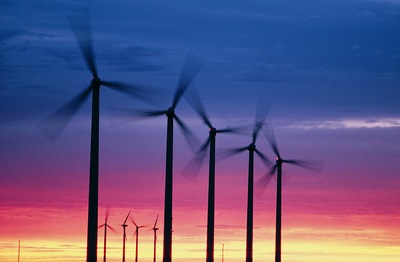Five ways to get a job in Michigan's emerging clean energy industry
The term “green jobs,” which is commonly propagated by politicians and business people alike, is deceptive because it ignores the complexities of the multi-faceted clean energy industry.
Designing wind turbine gears, producing polycrystalline silicone, creating lithium-ion cells and assembling electric vehicle battery packs are completely different jobs.

Many of the jobs in the wind turbine manufacturing industry are popping up at component suppliers.
Photo courtesy of Business Wire
All green, yes. But they require significantly different skills.
Experts gathered Thursday and Friday at the University of Michigan for a Michigan Memorial Phoenix Energy Institute conference called, “Revitalizing Innovation in Michigan for Clean Energy Manufacturing.” After attending a panel on the kinds of jobs that are emerging in clean energy industries, I thought I should pass along a few tips.
Here are five ways to get a job in Michigan’s emerging clean energy industry:
1. Find a community college program that is retraining traditional manufacturing workers for specific clean-tech industries.
Les Alexander, who leads battery maker A123Systems’ Ann Arbor operation, said his firm is working with several community colleges to develop battery manufacturing training courses.
“Down the road you will see a number of community colleges that are putting (similar) curriculum in place,” Alexander said.
2. Research the skills necessary to manufacture wind turbines, blades and components and match them up with skills you gained while working in an automotive assembly plant. Be willing to learn.
“A lot of that is transferable,” said Charles Vaughan, vice president of commercialization for wind turbine manufacturer Northern Power Systems, which is building a plant in Saginaw.
There’s “nothing that would preclude a skilled factory worker in the automotive industry from transitioning over. There’s a lot of similarities between assembling automobiles and assembling wind turbines,” Vaughn said.
3. Understand the dynamics of the emerging supply chains for wind turbine makers, solar panel manufacturers and battery producers. Many of the jobs are popping up at component suppliers, including materials companies like Hemlock Semiconductor, Compact Power and Dow Chemical.
Dan Radomski, an alternative energy consultant with Kinetik Partners, said a typical wind turbine has more than 8,000 parts.
4. Get a degree in materials science, systems engineering and other technical fields, and prepare to step into a completely different environment and work culture.
You might be able to get a job manufacturing clean energy devices without a college degree. But designing batteries, solar panels and wind turbines requires advanced degrees.
“The jump from making a seat or a lead acid battery to making an advanced battery with lithium-ion (chemistry) is a pretty big jump,” said Steve Vielmetti, vice president of strategic value chain for Johnson Controls, which is building a battery plant in Holland. “It’s a very different world. It’s a highly technical, clean-room environment. It’s a big change, though we’re finding the workforce is stepping up and we are finding the people we need.”
Alexander said systems engineers are in high demand at battery companies.
“These systems that are coming online now — they need to be integrated, they need to be able to talk to each other, they need to be able to function,” he said.
5. Don’t assume you’re unemployable just because you’re unemployed.
Alexander said A123Systems, which last year opened its battery production plant in Livonia, has hired about 500 workers for its manufacturing operations so far. About half of those were previously unemployed, he said.
“They’re displaced auto workers for the most part,” Alexander said. “A lot of them are high school diploma workers who have had anywhere from 10 to 20 years of experience working at auto plants.”
Contact AnnArbor.com's Nathan Bomey at (734) 623-2587 or nathanbomey@annarbor.com. You can also follow him on Twitter or subscribe to AnnArbor.com's newsletters.


Comments
xmo
Sat, Apr 23, 2011 : 10 p.m.
Green Jobs sounds cool and all but at the end of the day, can we really afford a "Green Economy"? Green Economy's are for rich nations that can afford to recycle and place limits on their out put (GNP). We are in trouble if you have not noticed! Maybe after 2012
DBlaine
Sat, Apr 23, 2011 : 11:16 p.m.
Can we afford not to reduce the negative externalities caused by our economy? The same arguments were used to oppose the Clean Air Act. "It'll kill jobs and the economy." "It's too expensive" "Other countries will surpass us economically." Guess what? That was all a bunch of bull. The Clean Air Act has saved us billions. Fewer people dying of air pollution. Fewer people getting sick. The health benefits alone -- and avoidance of lost wages, productivity and health care -- made the act an economically sensible thing to do. This is no different.
julieswhimsies
Sat, Apr 23, 2011 : 4:36 p.m.
Thank you. Excellent advice!
runbum03
Sat, Apr 23, 2011 : 4:16 p.m.
I like to track just who is lining their pockets with federal money. As for "green jobs," how did that work out for Spain and their 22% unemployment? LOL.